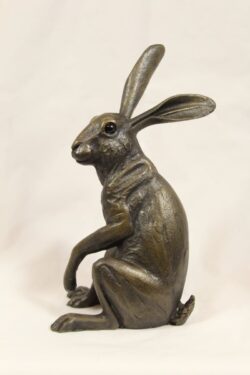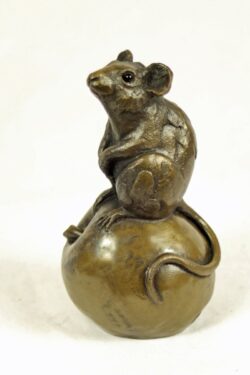Description
bronze resin Wren on apple
You so often hear a wren rather than see them and when you do they’re off in a flash. This one has found an apple to perch on for a moment while it surveys its surrounding. Look well, he’ll be off before you know it.
Wrens
Wrens are one of my favourite birds, really noisy and feisty for their size. We used to have a honeysuckle outside the window of our downstairs loo, a wren lived in there, if you were lucky you could enjoy watching it while you were sitting down!
The wren is a tiny brown bird, It is dumpy, almost rounded, with a fine bill, quite long legs and toes, very short round wings and a short, narrow tail which is sometimes cocked up vertically. The 9- to 10.5-cm-long and 6-10 g wren is rufous brown above, greyer beneath, barred with darker brown and grey, even on wings and tail. The bill is dark brown, the legs pale brown. Young birds are less distinctly barred.For such a small bird it has a remarkably loud voice. Singing is most important at dawn, since this is when intruding males may attempt to steal territory. Defending males meet their challenger with song and females listen to the vocal contests. If they like what they hear, they may sneak off and seek extra-pair copulations.
Found across the UK in a wide range of habitats – woodland, farmland, heathland, moorland and islands. Most are found in deciduous woodland but it is least abundant in Scotland and northern England, with the smallest numbers found in upland areas. A regular visitor to most gardens. At night, usually in winter, it often roosts in dark retreats, snug holes and even old nests. In hard weather, it may do so in parties, consisting of either the family or of many individuals gathered together for warmth.
For the most part insects and spiders are its food, but in winter large pupae are taken and some seeds.
The male wren builds several nests, up to 6 or 7. These are called “cock nests” but are never lined until the female chooses one to use.
The normal round nest of grass, moss, lichens or leaves is tucked into a hole in a wall, tree trunk, crack in a rock or corner of a building, but it is often built in bushes or overhanging boughs
Five to eight white or slightly speckled eggs are laid in April, and second broods are reared.
Wrens are highly polygamous, that is to say a male can have, at any one time, more than one female with an active nest on his territory. An active nest is one in which there are eggs or nestlings. A male has been recorded with four females breeding on his territory.
Wrens are Britain’s most common breeding bird, but their small size and reliance on insects mean they perish easily during prolonged periods of cold weather.
Resin Bronze Sculptures
When I make a sculpture I particularly like, I Have it moulded and cast in Bronze Resin. A process that creates an attractive and durable alternative to real bronze. The bronze resin animal sculptures have proved to be very popular as they are affordable and easy to send and I am continually adding to the range. My work is also available in galleries, mainly in the Westcountry.
Links
If you would like to find out more you can also check out my Facebook Page. Every year for Dorset Art Weeks I coordinate several like-minded artists and transform my home into a gallery. Check out the Horethorne Group facebook page as well for all the latest news.





